
Last week Missoula's first roundabout opened to the public. It was a pretty large event for the opening of an intersection; maybe because it was built with stimulus money and was the first large project to be completed in the state of Montana. A lot of big political players sent people from their offices, such as Senators Tester and Baucus and all the local politicians were on hand for the ribbon cutting.
Before I get any farther along though, I would like to point people's attention to the photo above. Hopefully people can notice the abundance of signage present; 32 in all, even everyone in my Land Use Planning class thought that was a little excessive. I think Montana's DOT was a little scarred of stupid or distracted drivers driving through the middle.
Of course I believe the signage itself is a bit distracting, and even with all the signs people in cars still tried to blow through the intersection when it first opened. Most of these people were on cell phones and one even came close to running over city councilman Jason Wiener.
Here in America, traffic engineers like to tell the public exactly what type of behavior is expected of them, mostly through signs (but then we do things like have speed limits on wide, open, and straight roads that encourage speeding). Drivers are mostly o.k. with this, since it allows them not to have to think too much while simultaneously being on the phone.
But does having 32 signs at a roundabout do anything for safety, or does it fill a contractor's pockets? A roundabout is a perfect situation for "shared space," a concept first proposed by Hans Monderman. Essentially, shared space takes away all on road instructions and allows users of the road to "negotiate" with one another for road space. The intent is to slow traffic, increase safety, and allow all users to share the road more equitably. I can almost guarantee that most people's reaction to this idea in America would anger and puzzlement. There are places in America that already implement this principal, such as Savannah, GA as pointed out at the Proper Scale blog.
Anyway... back to the opening ceremony. Below is the ribbon cutting ceremony performed by our mayor, John Engen and Jim Lynch, head of the MDOT.
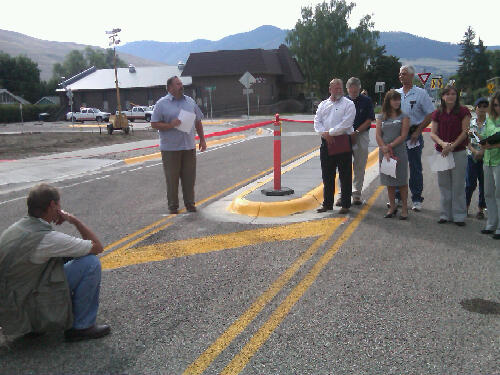
And what would the opening of a roundabout be without cyclists to test it out? As you can see in the photo below, we had a pretty good turnout. The MDOT was giving out pamphlets on how cyclists and pedestrians should behave in the roundabout. It called for cyclists to dismount and walk their bikes through the cross-walks. Lets just say that none of us cyclists performed that stunt.
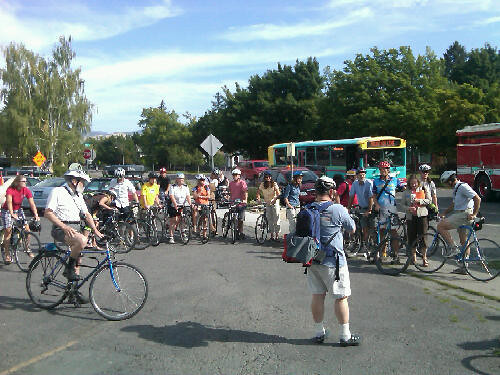


And what would the opening of a roundabout be without cyclists to test it out? As you can see in the photo below, we had a pretty good turnout. The MDOT was giving out pamphlets on how cyclists and pedestrians should behave in the roundabout. It called for cyclists to dismount and walk their bikes through the cross-walks. Lets just say that none of us cyclists performed that stunt.

Missoula's own bicycle ambassadors, where there to educate the riding public about proper on street behavior. Ben even had a hand painted helmet on, go Vikings!

Dogs even came out to participate in such a monumental moment. Below is a BWAM member's dog along for the first ride through the roundabout.
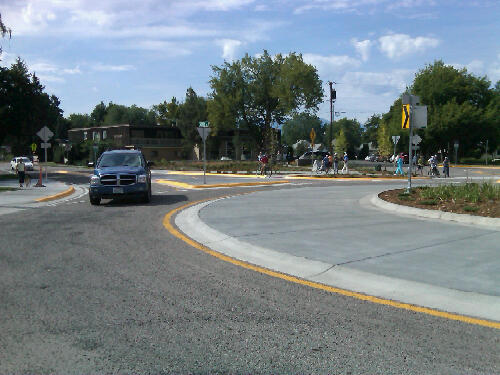
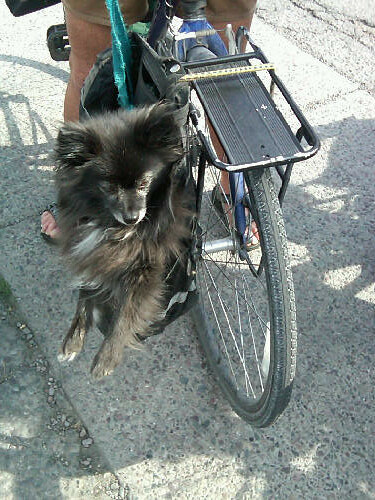




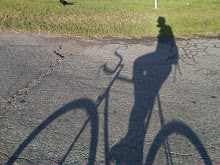
4 comments:
Thanks for visiting my blog CarFree...and congrads to Missoula for your first roundabout. I'm hoping the signage overabundance eventually comes off like training wheels. With all that signage, I wonder if a traffic light would have been cheaper! LOL. But I hope Montana folk eventually give up signage like they gave up speed limits that time in the 90's...It's about freedom folks!!
Savannah's circulation strategy follows the one-way dynamic of a roundabout but with a few important differences inherent to a cohesively integrated network. Savannah's squares have a tremendous lot to teach. I'll have to make the next compare/contrast installment of my "Odonomy" series on the square vs. the roundabout.
The Wilson Quarterly did an excellent article on the significance of Monderman's contribution to traffic engineering. Very worthy read that I always point people to, since it presents the development of Monderman's underlying psychological and philosophical insights... http://is.gd/39nuU
It will be interesting to watch how the drivers of Missoula adapt to this new "Speed Bump." I wonder if it wasn't the most expensive way possible to solve the problems at this intersection.
The little roundabouts in neighborhoods seem to have slowed traffic on the side streets. I guess this was a different idea on building speed bumps. Luckily the city councilman did not become a speed bump.
Thanks for your input Rick.
While the initial cost of the construction for the roundabout was higher, I think by about 30%, but I could be wrong. From everything I have found on roundabouts is that the lifetime costs of the intersection will be about 80-90% lower than with a signalized alternative, as maintanence costs run about $3500-$5000 a year on a signalized intersection.
Also, the costs associated with vehicle accidents will be significantly reduced, as most accidents at a roundabout are low speed fender-benders that don't result in major injuries or fatalities. With signalized intersections, whoever, most accidents are at greater speeds and there are about 30-40% more accidents that involve major injuries or deaths.
I personally think that once people get used to it the intersection will operate pretty smoothly and people will like the improvement.
Post a Comment